Maybe I am a little biased, but I don't think it's fair to blame it all on Barbie. I feel ambivalent when I hear women blame their low self esteem and poor body image on growing up with Barbie dolls. Like so many other American women, I have struggled with my own self-perception when it comes to weight and body type, though I don't know if Barbie is entirely to blame. And then there is the fact that I am an avid doll collector. This further complicates my attitude towards fashion dolls. I enjoy collecting them and buying clothes for them, even as an adult.
The negative messages girls receive these days come in a variety of guises and packages. But I chose dolls to illustrate these messages because they can not only depict them, but embody them. The idea for The Doll Project came to me while I was brainstorming ideas for Worth Waiting For. I imagined a skeletal doll standing on a scale with a speech balloon over her head with the caption "I just need to lose 5 more pounds." I would create professional looking packaging for the doll and label it "My First Diet." At first I thought of using a skeleton around 11.5" tall, which is the height of a Barbie doll. But as I considered the origins of eating disorders, I thought it would make more sense to portray a teenager, someone Skipper's age, perhaps. But with more and more girls doing things at younger ages these days, I thought that using a Stacie doll would be more appropriate.
Instead of a skull with hair on its head, which was the original plan before I was outbid on a Barbie sized wig on eBay, I decided that the doll needed a normal looking head. There were many to choose from. I chose Stacie because of the expression in her eyes. No one can paint expressive doll eyes quite as well as the people at Mattel. I guess that is the doll collector in me talking. If I hadn't gotten Stacie, I may have used Licca, a beautiful doll from Japan. But price was an issue. I just couldn't justify spending that kind of money on a doll to dismember. Being a collector who even as a child was careful with her dolls, I have a hard time even disassembling dolls to make this project! Fortunately the doll I chose was inexpensive. And that sweet expressive face makes Ana a sympathetic character, despite her skeletal body.
That's another thing I want to avoid: ridicule. I do not wish to belittle my subject matter. I wanted to treat it seriously. I considered each detail very carefully, from the clothes to the accessories, to the hairstyle. But in the end, I wanted Ana to be an archetype of how girls used to be portrayed as dolls: pigtails and bangs, in a knee-length a-line dress with a cute pattern. Her blond hair and blue eyes fit the fashion doll tradition of the blond as main character with redheaded, brunette, and occasional "ethnic" friends. Sadly, this is a pattern most manufacturers continue to the present day, with a few slight modifications. But that could be the subject of a whole new doll project. And maybe I'll do something with that concept in a future project.
Anyway, back to Ana. I named her after Internet shorthand amongst eating disordered teens. They call anorexia Ana and bulimia Mia as if they are two classmates they know from school. The sad thing about Internet communities is that they allow like-minded people to congregate even when the thing that brings them together is their own self-hatred and self-destruction.
Next in the series was, of course, Mia. As I gathered the accessories for Mia, who represents, as her nickname suggests, bulimia, it occurred to me that no fashion dolls have any problems with food. Barbie's refrigerator contains a vast array of items from all parts of the food pyramid. She isn't afraid to be around it. Among her many professions (well, before she became a butterfly fairy princess mermaid) she has been a pastry chef and has even flipped tiny burgers at her own little 1:6 scale McDonald's. It appears that in her world there are no "bad" foods, and she does not diet. Nothing I know of (though I could be wrong) encourages that kind of play. So who are girls getting all this lipophobia from? Their mothers, of course. And big sisters. And the fashion magazines. And diet ads. Think about it. Next to some of our top runway models, Barbie looks overweight! The Top Model Barbies are more than likely curvier than the actual models they represent.
But in Mia's world, there are bad foods. And unlike Ana, she cannot be a "good little girl" and forbid herself from partaking of them. But she cannot gain weight either, so she purges. Ana and Mia are two sides of the same irrational extremes. They remind me of the kind of disordered logic exhibited on the covers of magazines targeted to middle-aged women: a big glossy photo of a decadent, elaborately decorated cake while the text superimposed above it heralds the discovery of a new way to lose weight. So for many, having the cake, eating it too, and still being able to wear a size 0 ultimately means forcing oneself to vomit the cake back up. How could there not be bulimic people in such a society? Extreme thinness in a land of plenty practically demands it.
So that is the philosophy behind that portion of the doll project so far. Stay tuned for updates as I take pictures of other girls in the series.
Also, if anyone knows of any art shows that this work would be thematically appropriate for, please let me know.
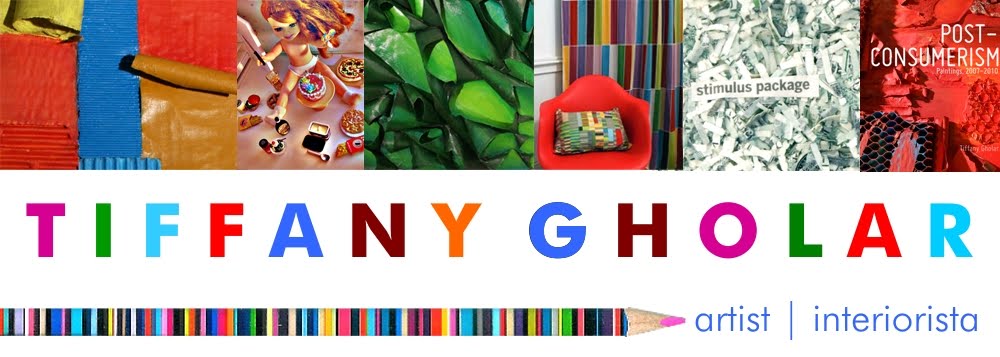
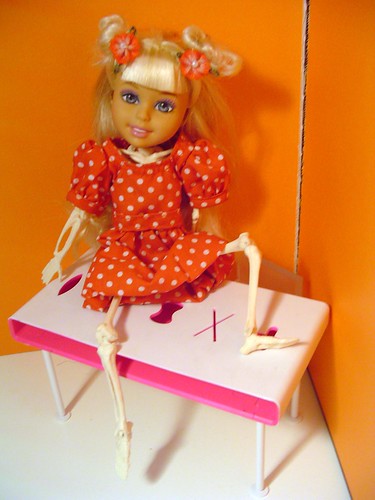


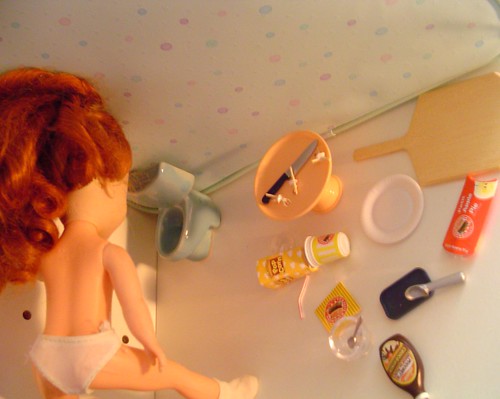
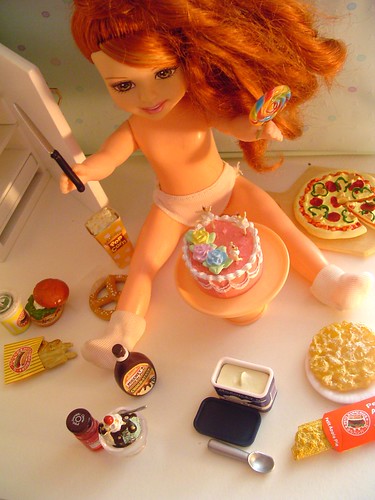
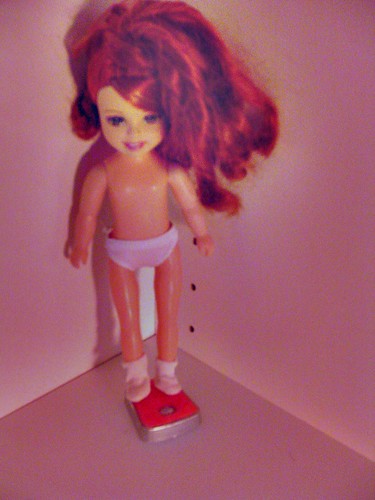
I love this idea!!! Right on for harnessing your creativity to make such provocative statements.
ReplyDeleteAhh...Skipper and Stacie....that took me right down memory lane. *heehee!*
Thanks, Hope! Poor Skipper. I wonder if they'll ever bring her back?
ReplyDeletehi there!
ReplyDeleteI love your project and the message it gives to all girls out there who are starving themselves just to 'fit in' to the so-called standard of being beautiful.
Good job! Keep up the good work..:D
I think this is a wonderful and worthwhile project. I agree that Barbie dolls, etc, don't necessarily cause EDs (that's a rather shallow interpretation, if you ask me), But they do hold up the ideal of a woman as being far too thin.
ReplyDelete